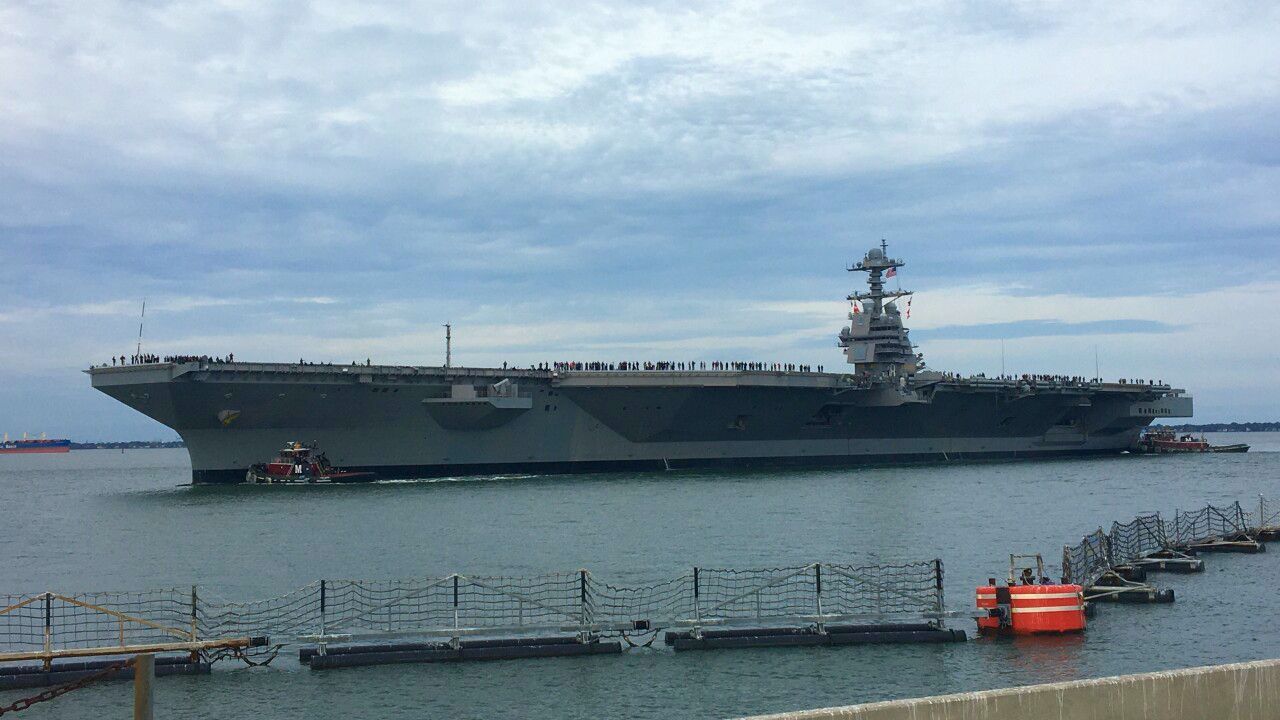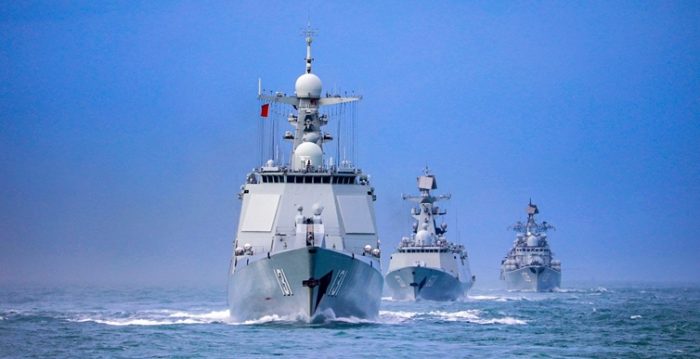The renewed American focus on the Israel-Hamas conflict with the deployment of aircraft carriers in the eastern Mediterranean and increased arms supplies to Tel Aviv could come as a blessing for both China and Russia, as the US will be hard-pressed to tackle multiple conflict zones in Europe, Western Pacific, and West Asia simultaneously.
Earlier this month, reports in The Wall Street Journal (WSJ), Politico, and Times of Israel (TOI) said the US could send its USS Dwight D. Eisenhower carrier battle group to join the USS Gerald R. Force CBG already operating in the eastern Mediterranean in support of Israel’s operations on Hamas in the Gaza Strip.
This is seen as the American move to deter other nations in the region, such as Iran, that are inimical to Israel from taking advantage of the situation and invading Israel while opening up multiple war fronts to besiege the Jewish nation.
Tel Aviv has also called on Washington to ramp up its arms supplies to replenish the weapons and ammunition the Israeli Defense Forces expended against Hamas in the Gaza Strip.
The situation has bared how the US might not be able to support all its allies, and certainly not at all at once when strategic rivals can exploit its preoccupation at multiple flashpoints. This intersection of conflicts in various regions, directly impacting the other, has, therefore, gotten starker.
China Has Larger Fleet; US Navy Will Need All It Has
But the US Navy’s enhanced presence in the Mediterranean during the Israel-Hamas war is one of the worst fears of American strategists coming true. The US and Western naval experts have long pointed out that a larger fleet size always wins in naval wars, even when the adversary with the more significant force is relatively inferior in terms of technology.
China’s shipbuilding can not only churn out ships at a faster pace, but it is also a far more considerable force at 350 ships, which surpassed the US Navy (USN). This is not to mention the US’s shipbuilding infrastructure’s fledgling state. It has motivated plans to outsource building boats to allies like Japan to take the load off overburdened shipyards back home.

Therefore, the need for the USN to have its full might before China will not be met, given the unexpected conflict in the Middle East. In the January 2023 issue of the US Naval Institute’s Proceedings magazine, Captain Sam J. Tangredi touched upon the PLA Navy’s superior numbers that tip the scales in favor of Beijing in the western Pacific.
“Not only does quantity have a quality all its own, but it also almost always proves decisive in naval warfare when professional competence is equal. A primary reason is that technological advantages were inevitably short-lived. In a war between equally competent technological near peers – absent a series of amazing strokes of luck – the larger fleet always won,” he said.
The PLAN armada surpassed the USN around 2020 and now has around 340 warships, according to the Pentagon’s November 2022 China Military Power Report. It is expected to grow to 400 ships by late 2024. Meanwhile, the US fleet sits under 300 ships, and the Pentagon’s goal is to have 350 manned ships, still well behind China, by 2045, according to the US Navy’s Navigation Plan 2022.
The USN would, therefore, have to bring down to bear all its might before China in a war, and any diversion of resources would weaken its already precarious military position.
US Weak Technologically & Logistically Too
Neither does Washington enjoy military technological superiority anymore. China has fielded unorthodox missile systems that simultaneously take out an incoming US fleet and surrounding military bases in the First Island Chain, even before employing its tactics.
In the South China Sea, the Chinese have a ‘home advantage’ and missiles that outrange any in the US inventory. The YJ-18 anti-ship cruise missile (540 kilometers) and the PL-15 Beyond Visual Range air-to-air missile (300 kilometers) outrange the US’s 240-kilometer range Harpoons and the 161-kilometer AIM 190D.
In contrast, the DF-21D missile threatens US aircraft carriers. This erodes the US Navy’s capacity (or payload) advantage. “What could US ships be launching in response? Nothing at the ranges we are talking about,” said former US Navy officer Bryan Clark.

Even China’s diverse range of ballistic missiles can be used to pre-emptively take US, Japanese, and Australian bases. The DF-16 short-range ballistic missile (SRBM) can reach 1000 kilometers, bringing all the first island chain targets within reach.
The 1,500-2,000 kilometers range DF-21D’ carrier killer’ anti-ship ballistic missile (ASBM) can hit the second island chains and any approaching US naval flotilla. The DF-26 intermediate-range ballistic missile (IRBM) can reach 3,500 kilometers, hitting the most crucial yet farthest US naval base in the western Pacific – Guam.
Successive US naval commanders and military leaders have consistently admitted how they were technologically unprepared before these threats, besides their logistical inability to keep their ships and bases resupplied with fuel, food, and firepower. Previous EurAsian Times reports on this aspect can be read here and here.
If the Israel-Hamas war lengthens, the US would have to extend the deployment of the Ford and Eisenhower CBGs in the eastern Mediterranean. That leaves only one CBG in the western Pacific, dwarfing in size a flotilla the PLAN can sail into the warzone.
Overlap With Europe
The impact of a US deployment and sudden occupation with the Gaza war has already begun impacting the battlefield in the European theater. Ukrainian President Volodymyr Zelenskyy has expressed concern about weapons donations to his country being diverted to Israel. CNN reported his surprise visit to the NATO headquarters in Brussels.

“The Ukrainian president was forced to address a crisis currently drawing more attention than Moscow’s invasion of his country: the brutal attack by Hamas on Israel. This is a critical moment for Ukraine, especially as international fatigue starts to set in and the world’s attention shifts to the Middle East,” said the report.
While it can be just a coincidence, the US engagement with Israel and Hamas was instantly followed by Russia launching a sudden offensive at Avdeevka, a noted Ukrainian stronghold. It would have been part of Moscow’s broad, long-term plan to launch its tactical offensives at some point.
But it cannot be denied that the unexpected attention towards the Middle East was also a surprise opportunity Russia exploited. But they were also unbelievably stunned – precisely how Israel was when Hamas struck. Russia made a sudden frontal hit at a mighty, heavily fortified stronghold they never expected to be attacked.
Russian ground forces can be assumed to have seized an unexpected opportunity by wasting no time. Whether its attacks succeed or are beaten back by the Ukrainians remains to be seen, but that Kyiv was left with a rude shock is certain.
As of October 12, the attack seemed to progress well, based on videos of the Russian advances in and around the town. Russia, too, has been reported to have lost considerable armor in the process. Still, it cannot be denied that it has severely curtailed Ukraine’s ability to bomb Donetsk from Avdeevka.
Conclusion
This marks an unprecedented situation where wars and conflicts raging in one part of the world directly impact other flashpoints with different actors and geographies. Moreover, each anti-West adversary in these different theaters (Russia, Iran/Hamas, and China) is fully united strategically in what they perceive as US hegemony.
But the same cannot be said for US allies in these theaters, who do not necessarily view US rivals as their adversaries. Ukraine and Israel do not perceive China as a threat, and Japan and Iran do not conceivably find the other militarily and existentially provocative. This limits the options of uniting them against Washington’s strategic opponents.
Israel has rather been riding high with its unprecedented economic ties with China under the latter’s Belt and Road Initiative (BRI) — a relationship personally pushed by Prime Minister Benjamin Netanyahu himself. It has also long been resisting US pressure to not proceed with Beijing’s investment in its ports and 5G communications infrastructure.
These contradictions will go against the US-led Western coalition as the conflicts in these flashpoints unfold, signaling the challenge posed by alternative global power structures led by Russia and China.
- The author can be reached at satamp@gmail.com
- Follow EurAsian Times on Google News




